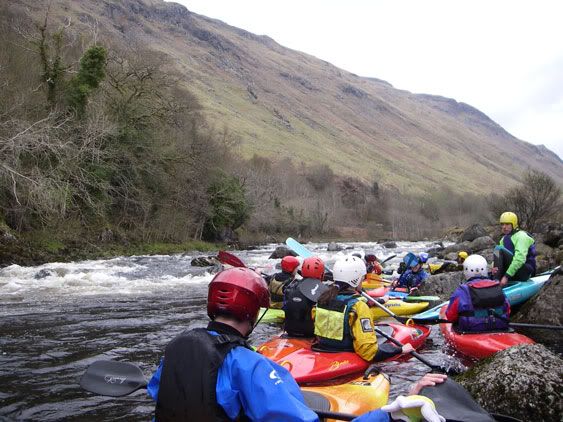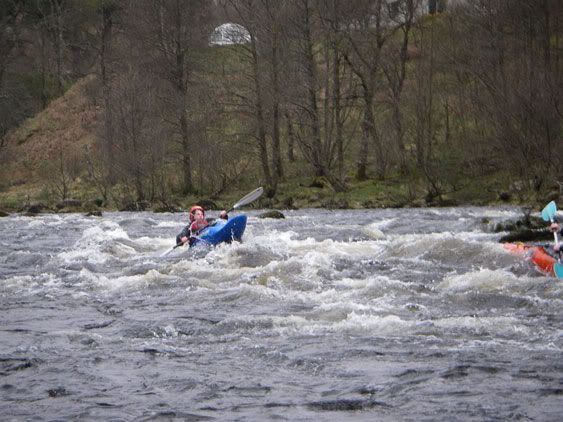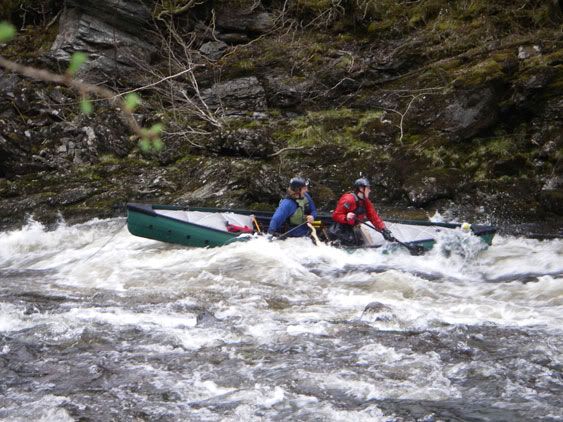IntroductionsOur second Song of the Paddle meet-up was a weekend-long flatwater trip on Loch Lomond (pronounced Low-mond, not like the cyclist). We hired a car from Enterprise and much to Lucas’ delight, it was a Nissan Micra, the car of his UK dreams. We loaded up gear and headed west. I did the “usual” city driving and let him have a go in the boonies near Callandar. Our get-in at Balmaha was familiar from our Ben Lomond trip with the Czechs, so much of the drive was a repeat except with a happy little car instead of the Corsatanker. In my eyes, the Micra is no MINI, but as far as borrowed cars go, I can’t complain.
We arrived at the get-in sometime after 6pm, which by April in Scotland standards, gave us plenty of daylight for Pakboat assembly and paddling to camp. The occasional gawks of passersby are becoming more commonplace. A little after 7pm, we were on the water paddling to Inchcailloch, the island across from Balmaha whose name means “island of the old women.”
We were among the last of the arrivals for Friday night, with many having taken Friday off completely for more time on the water. We met Cara (Silvergirl), John (MagiKelly), Maggie (Mutineering Maggie) and several others at the beach. Maggie and Alan were familiar faces from the River Dochart trip. I wandered over to watch and photograph the sunset with Alan while Lucas worried about getting the tent set up before dark. Perhaps I should have told him that sunset in April isn’t as committing as sunset in early January, and he would have plenty of light for tent assembly? Nah, lesson learned.
Probably the most heralded of Friday night arrivals was Grooveski in his inflatable kayak, for not only did he bring much wood for campfires but also whiskey to enhance the warmth of the campfire. His was among several bottles that made the rounds that night.
Wallaby Safari on the High SeasForecasts for Saturday said much wind was headed our way. When Lucas awoke, the air was still and the water glass. He zipped out of the tent with haste for a sunrise paddle while I burrowed further into my sleeping bag for more sleep. I awoke to a proper morning, closer to 7 or 8. Cara was kind enough to lend us one of her stoves, a Trangia, and I promptly fell in love. No bottles or joints or twisting metal parts. Dump fuel into cup, toss in a match, zoom. I want one.
The Brits in the group rolled their eyes and scolded us for porridge with brown sugar. Apparently, we are supposed to eat porridge with just a dash of salt. Er. Sure.
Over breakfast, we discussed paddling plans for the day. Many of us were keen to see the wallabies on Inchconnachan, but concerned about the threatened wind. We decided to head out post haste in hopes that wallabies could be stalked and found well, and the return paddle completed, before the wind picked up. By the time we left, the still of the loch was gone, replaced by a slight breeze.
Four boats set out for wallabies, Lucas and I as well as Maggie and Alan in tandems, with Cara and David each in solos. I started the day in the stern. The plan was to dart across the open crossings as fast as possible and regroup among the protected islands. Open crossings would be the most hazardous part of the paddle. Jim and Jacqui caught up with us at the first regrouping. It felt like less than an hour’s paddle to reach Inchconnachan. The first beach had camps by the occupants several anchored motorboats, so we went around the island to the beach where Jim and John had camped in the winter and been visited by chocolate-hungry wallabies.
Jim and Jacqui set up a brew on the beach while Cara, Maggie, Alan, David, Lucas and I went on our wallaby safari. We walked up to the highest point of the island and were starting to experience wallaby doubts until eagle-eyed Cara spotted the first hanging out in the brush. The wallaby sat there like a large rabbit (David’s word), allowing many photographs before halfheartedly darting into the brush. I captured a wallaby profile run, confirming that s/he was not a large rabbit. We circled the brush to find it sitting and apparently waiting for more photographs. Cameras ticked away as s/he darted into the brush again.
During this time, Maggie spotted six more running through the brush at the bottom of the hill. We followed in pursuit, but the wallabies were too fast for anyone to even catch a glimpse. More wandering found us staring at our second wallaby, who was about as bashful as the first. No doubt s/he knew we were watching. More photos. Finally, we decided to return to the beach for a short lunch and more paddling.
With the wind still reasonably in our favor, we chose to circumnavigate Wallaby Island and then head back to camp. Unfortunately, the wind picked up mid circumference. Cara and David in the solos were the first to be battered. They chose to team up, paddling tandem and towing the other solo. They made much better, but still slow progress. Lucas and I swapped places as the battering by the wind and the chop made things much more serious.
We reached a sheltered point on Inchconnachan and come up with a plan, er rather Plan A, Plan B, etc. The open water crossings were unavoidable and the wind was strong enough to create some pretty good chop in the exposed portions. We traced shorelines where possible, but two open water crossings were absolutely unavoidable. Plan A was to make the shortest crossing possible to the next island. Plan B was to just get there. Somewhere around the first crossing, Cara and David met up with Tony and Nicky (aka Mr. & Mrs. Tenboats) and decided to raft up for safety reasons. The rest of us continued with Plan A.
In the middle of the first crossing, the swells were a good two feet in height with occasional three footers to keep things interesting. In the unladen Pakboat, our progress was slow. The great thing about the Pakboat was its bendy frame rolling over the waves. The not so great thing was the apparent lack of power we were getting in our ferry glide across the open seas. Jim and Jacqui were in a similar bendy boat and making much better progress, so we blamed the seat configuration. Lucas had positioned the bow seat slightly farther back than the usual flatwater configuration to counteract the Pakboat’s natural anti-rocker.
A little more than halfway across, our attempt at Plan A was aborted and we opted for Plan B to the lower end of the island using the waves to help us get there. Another 20 minutes of paddling and one good argument later, we arrived intact. Just as we got to the island’s shore, one of those big boats with the motors passed by, kicking up some good sized wakes that in turn kicked us farther onto the shore.
One by one, our compatriots who had succeeded at least in part at Plan A trickled in to join us in our wee nip of shelter. The last to arrive were the makeshift Tenboats-et-al raft. They had sailed down most of the way to join us, but had to paddle in to our wind eddy shelter. With all due respect to their skills as paddlers, the mental image that I processed of the canoe raft channeled an old Far Side cartoon: Ship of Fools / Car of Idiots.
More introductions followed. Maggie wanted to see if the house on the island would do B&B. She laughed as she said it, but there was a glimmer of seriousness in her words. I can’t say that I blame her. We discussed a plan for the last open water crossing to get back to camp. This crossing was shorter, but the wind seemed to pick up even more to add to the challenge. I don’t really remember if there was a Plan A or a Plan B or Plan C, except to hug the coast as much as possible before making the “dart” across the open water. It sort of became a free-for-all. Given most of our lack of experience with high wind loch paddling, a free-for-all probably wasn’t all that bad an idea. Staying together would be nice, but honestly, a rescue would have been chaos no matter what.
Initially, Alan and Maggie and the bendy boat were making decent progress across the swells, managing to move forward as well as across. In the Pakboat, we were making much less progress – even the makeshift raft was moving forward faster than us. Finally, Lucas figured out that if we swapped sides when getting too far battered, we could make some progress forward. I think it took another half hour at least to get anywhere close to the Inchcailloch shore. The closer we got, the more forward progress. We had lurched ahead of the raft, too. I suggested to Lucas that we consider a portage along Inchcailloch’s nature trail as last resort option. Probably it would have been faster to land the boat and hike then continue paddling, but we kept at it.
Probably a good twenty minutes later, we saw a red canoe on the beach along with Alan and Maggie, and a few others along to gawk and help haul gear. We forged forward. Around the next bend, the waves beating against the island got bigger as that shore was fully exposed to the wind. I didn’t like the looks of it and didn’t feel the risk was worthwhile, given the lack of fun involved. I said to Lucas that I thought it foolish to continue. He respected my choice and we beached the boat safely nearby the first boat. Greeted by friendly faces and Grooveski’s “Well done!”, I was grateful to be back on the beach.
Lucas resumed giant turtle mode carrying the Pakboat back to camp as I alternated between leading the way and helping him balance the boat. I wandered back to the landing beach to check on the raft’s progress and help with others’ gear. The raft opted to use the same landing, so I had plenty to help haul. Two canoes and their respective gear. Tony and Nicky decided to try their luck at paddling/poling back to camp unladen, with their dog watching nervously from the bank. They arrived after the last of the gear had found its way back to camp.
With the wind came the rain. Dinner that night was a lavish affair, with many an avid Bushcrafter whipping out a tarp for shelter. John took the lead on assembling shelter. We moved picnic benches under the resulting shelter and everyone cooked, ate and laughed together.
Someone spotted Inchcailloch’s famous white deer in the distance, eyeing us suspiciously, I’m sure. After dinner and dessert, we joined Maggie and Alan as well as others for a rainy hike to Inchcailloch’s summit. Hiking in the rain was much warmer than sitting under the tarps. The view from the summit was impressive, not for the visibility but for the lack thereof. We hiked down to another trail and spotted the white deer again eyeing us suspiciously. I snapped a few blurry pictures. Next stop was the graveyard. A few of the MacGregors (kin of Rob Roy) are buried there. The name of the island comes from the number of old women that were buried there. For a small graveyard, more than half I would guess belong to old women.
We walked back to camp and I was pretty well done for the night. Determined not to get cold, I made myself into a sleeping bag burrito, with the fleece changling as filling and sleeping bag itself folded into the blanket burrito shell. It worked. I slept well and stayed warm.
Calmer WatersSunday morning, we decided to try out the spray cover that would have been useful in the previous day’s high seas adventure. Better late than never?
We packed up camp and loaded gear into the Pakboat. Our plan for the morning was to paddle out to the wee castle that we never got the chance to see on the Wallaby Safari. Most of the remaining group planned to paddle back to Balmaha, drop off gear and then head out to paddle, so we bid everyone farewell. Our two reasons for not following their example were (1) the Pakboat handles better with gear than without and (2) reality was waiting over there in the car park. We would get there soon enough.
Sunday morning was still plenty windy, but not nearly so intense. The glass-like water of Saturday morning was not going to return, but the swells of Saturday afternoon were not either. We followed a similar initial route as the Wallaby Safari, paddling across the open water as quickly as possible. The warm sun was a nice bonus.
Spray cover or no spray cover, I decided I am not a fan of sitting on the seats. Sort of a lazy church kneel was much more comfortable and efficient.
We enjoyed a nice paddle to the castle island with only a little bit of chop. It was hard to tell if the spray cover made a huge difference or not – Saturday would have been a much better test – but it did make some. At the very least, from my torso down was plenty warm.
Nearing the corner of the last island before the castle, we actually had a hard time seeing the castle itself. It is indeed a wee castle on a wee island. We beached the boat among the least amount of branches and got out to explore. Trees were growing out from among the ruins, but the stairs in were intact. The castle turned out to be inhabited. A nesting goose was perched at the opposite door. She was less than thrilled to see us, but made no protests. We left her to her duties and set out for ours – mine was to unpack lunch and Lucas’ was to turn the spray cover around. He had realized post-assembly that it was on backwards and it had bothered him the entire paddle to the island. I was less bothered, hence lunch.
After lunch, we bid the goose farewell and paddled back to Balmaha, back to reality and another workday that would, sadly, keep us off the water.
EpilogueBlogging tardiness means that you have to go
here to see the photos from the weekender. For the Song of the Paddle blogs and other people's photos, you can go
here. Enjoy!








